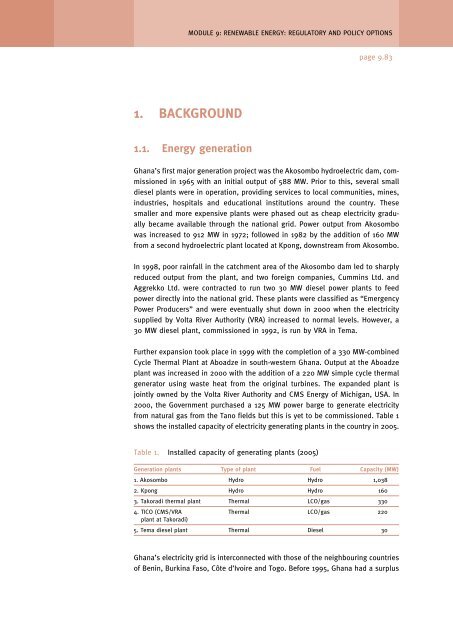Regulatory and policy options to encourage development of ...
Regulatory and policy options to encourage development of ...
Regulatory and policy options to encourage development of ...
- No tags were found...
Create successful ePaper yourself
Turn your PDF publications into a flip-book with our unique Google optimized e-Paper software.
MODULE 9: RENEWABLE ENERGY: REGULATORY AND POLICY OPTIONSpage 9.831. BACKGROUND1.1. Energy generationGhana’s first major generation project was the Akosombo hydroelectric dam, commissionedin 1965 with an initial output <strong>of</strong> 588 MW. Prior <strong>to</strong> this, several smalldiesel plants were in operation, providing services <strong>to</strong> local communities, mines,industries, hospitals <strong>and</strong> educational institutions around the country. Thesesmaller <strong>and</strong> more expensive plants were phased out as cheap electricity graduallybecame available through the national grid. Power output from Akosombowas increased <strong>to</strong> 912 MW in 1972; followed in 1982 by the addition <strong>of</strong> 160 MWfrom a second hydroelectric plant located at Kpong, downstream from Akosombo.In 1998, poor rainfall in the catchment area <strong>of</strong> the Akosombo dam led <strong>to</strong> sharplyreduced output from the plant, <strong>and</strong> two foreign companies, Cummins Ltd. <strong>and</strong>Aggrekko Ltd. were contracted <strong>to</strong> run two 30 MW diesel power plants <strong>to</strong> feedpower directly in<strong>to</strong> the national grid. These plants were classified as “EmergencyPower Producers” <strong>and</strong> were eventually shut down in 2000 when the electricitysupplied by Volta River Authority (VRA) increased <strong>to</strong> normal levels. However, a30 MW diesel plant, commissioned in 1992, is run by VRA in Tema.Further expansion <strong>to</strong>ok place in 1999 with the completion <strong>of</strong> a 330 MW-combinedCycle Thermal Plant at Aboadze in south-western Ghana. Output at the Aboadzeplant was increased in 2000 with the addition <strong>of</strong> a 220 MW simple cycle thermalgenera<strong>to</strong>r using waste heat from the original turbines. The exp<strong>and</strong>ed plant isjointly owned by the Volta River Authority <strong>and</strong> CMS Energy <strong>of</strong> Michigan, USA. In2000, the Government purchased a 125 MW power barge <strong>to</strong> generate electricityfrom natural gas from the Tano fields but this is yet <strong>to</strong> be commissioned. Table 1shows the installed capacity <strong>of</strong> electricity generating plants in the country in 2005.Table 1. Installed capacity <strong>of</strong> generating plants (2005)Generation plants Type <strong>of</strong> plant Fuel Capacity (MW)1. Akosombo Hydro Hydro 1,0382. Kpong Hydro Hydro 1603. Takoradi thermal plant Thermal LCO/gas 3304. TICO (CMS/VRA Thermal LCO/gas 220plant at Takoradi)5. Tema diesel plant Thermal Diesel 30Ghana’s electricity grid is interconnected with those <strong>of</strong> the neighbouring countries<strong>of</strong> Benin, Burkina Faso, Côte d’Ivoire <strong>and</strong> Togo. Before 1995, Ghana had a surplus










